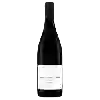
Château Grange CochardMorgon 'Les Charmes'
This wine is composed of 100% of the grape variety Gamay.
In the mouth this red wine is a with a nice freshness.
This wine generally goes well with pork, poultry or veal.
The Morgon 'Les Charmes' of the Château Grange Cochard is in the top 30 of wines of Morgon.
Taste structure of the Morgon 'Les Charmes' from the Château Grange Cochard
Light | Bold | |
Smooth | Tannic | |
Dry | Sweet | |
Soft | Acidic |
In the mouth the Morgon 'Les Charmes' of Château Grange Cochard in the region of Beaujolais is a with a nice freshness.
Wine flavors and olphactive analysis
On the nose the Morgon 'Les Charmes' of Château Grange Cochard in the region of Beaujolais often reveals types of flavors of cherry, oaky or blackberry and sometimes also flavors of red fruit, strawberries or plum.
Food and wine pairings with Morgon 'Les Charmes'
Pairings that work perfectly with Morgon 'Les Charmes'
Original food and wine pairings with Morgon 'Les Charmes'
The Morgon 'Les Charmes' of Château Grange Cochard matches generally quite well with dishes of veal, pork or poultry such as recipes of andouillette de troyes with chaource sauce, roast pork with prunes or chicken tagine with olives and potatoes.
Details and technical informations about Château Grange Cochard's Morgon 'Les Charmes'.
Discover the grape variety: Gamay noir
Gamay is a Burgundian grape variety that has existed since the 14th century. For fear of competition with the pinot noir of Burgundy, gamay was finally uprooted and planted in the Beaujolais region, from Mâcon to Lyon. These siliceous and granitic soils suit it perfectly, and it gives its best here. But it is also planted all over France, such as in Lorraine, in the Loire Valley, in Bugey, in Savoie and in Auvergne. Gamay is early and very productive and needs to be limited so that quality prevails over quantity. Short winter pruning of the shoots and high density of vines per hectare are the methods that allow it to produce very fruity, fresh and greedy red wines. Gamay is also very popular in red wine futures, and produces wines from the Beaujolais region with very interesting character and ageing potential. The AOCs Crémant-de-Bourgogne, Mâcon, Anjou, Touraine, Rosé de vallée de la Loire, Côtes-d'Auvergne, Saint-Pourçain, Bugey, Gaillac, Côtes du Luberon... and many vins de pays are proud of it. Today, about 36,000 hectares of Gamay are cultivated in France, including 22,000 hectares in Beaujolais.
Last vintages of this wine
The best vintages of Morgon 'Les Charmes' from Château Grange Cochard are 2015, 2020, 2019, 2011 and 2017.
Informations about the Château Grange Cochard
The Château Grange Cochard is one of of the world's greatest estates. It offers 9 wines for sale in the of Morgon to come and discover on site or to buy online.
The wine region of Morgon
Morgon is one of the ten Beaujolais crus located on the slopes of the Beaujolais hills, on the west bank of the Saône. The appellation applies only to red wines made from the Gamay Grape. Some white grapes are allowed in the Final blend: Chardonnay, Aligoté and Melon de Bourgogne. Although there are no officially defined quantities for these varieties, Morgon's blend is controlled by limiting the proportion of these varieties that are allowed in the Vineyard to a maximum of 15%.
The wine region of Beaujolais
Beaujolais is an important wine region in eastern France, famous for its vibrant, Fruity red wines made from Gamay. It is located immediately South of Burgundy, of which it is sometimes considered a Part, although it is in the administrative region of Rhône. The extensive plantings of Gamay in this region make Beaujolais one of the few regions in the world that is so concentrated on a single Grape variety. Pinot Noir is used in small quantities in red and rosé wines, but in the name of regional identity, it is being phased out and will only be allowed until the 2015 harvest.
The word of the wine: Sulphur
An antiseptic and antioxidant substance known since antiquity, probably already used by the Romans. But it was only in modern times that its use was rediscovered. It will allow a better conservation of the wine and thus favour its export. Sulphur also gave the 18th century winegrower the possibility of extending the maceration period without fearing that the wine would turn sour and thus go from dark rosé wines to the red wines of today. Excessive sulphur, on the other hand, kills happiness, paralysing the aromas and causing headaches.














